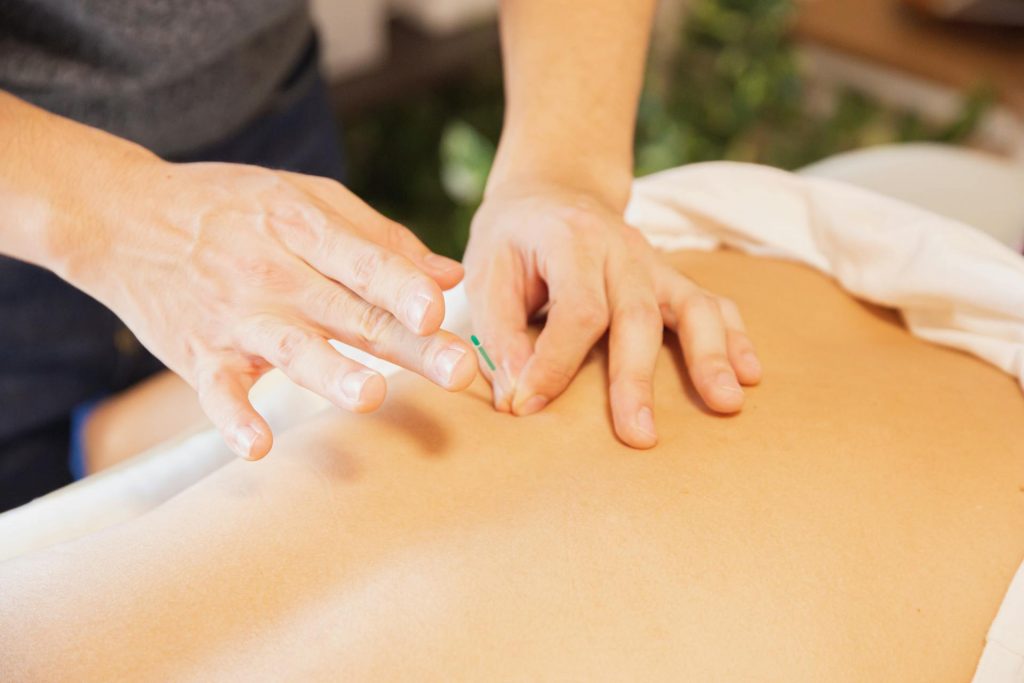09 Dec What is Dry Needling Therapy
Dry Needling or Dry Needling Therapy (DNT) is a technique often used by practitioners including myotherapists, remedial massage therapists and physiotherapists. It involves inserting needles into the soft tissue structures (muscle, fascia, skin etc.) of the body, to help relieve tension, reduce pain, and increase blood flow. The needles do not contain any fluid or medication, hence they are called “Dry” needles.

What is dry needling used for
DNT is commonly used to treat soft tissues (ie. muscles), with the goal of improving pain, improving tissues flexibility and restoring function. It involves the use of needles to release Trigger Points or hyperirritable spots located within the various muscles of the body. These Trigger Points can be formed whenever there is significant strain or stress applied to the muscle as well as from poor posture, sleeping habits, age or sedentary behaviour.
Trigger Points are formed within muscles generally due to some form of negative stimuli, this in turn causes the muscle to become irritated and tight which then causes pain and/or dysfunction when being used. These Trigger Points can be in the form of active Trigger Points which directly cause discomfort and can be felt at most times, and Latent Trigger Points which are points that are not able to be felt until pressure is applied directly to them, at which point they usually feel sore and tight as well.
DNT can then be used to specifically target these points in the body once identified and is then able to release these points with minimal pain in comparison to other techniques.
Is dry needling the same as acupuncture?
No. Although both utilize the same type of needles inserted into the skin, it is a different training and qualification to provide DNT and a different philosophy on how the needles work. A key difference is where the needles are inserted into the body. For DNT, needles are often inserted directly into trigger points in soft tissues or near nerve endings, while acupuncture places needles along meridian or Qi lines.
What does needling feel like?
At times when DNT is being performed there may be a jolt felt or ‘a twitch’ within the muscle body, this sensation is usually caused by the tip of the needle hitting the Trigger Point or another sore or taut band of muscle. This jolt will generally lead to a sense of relief in the muscle as the area relaxes back to a normal level instead of the agitated state it was in prior.
Which parts of the body can you needle?
DNT can be performed in many areas of the body such as the Neck, Back, Arms and Legs. Some areas such as the Forearm, Calf, Upper Trapezius, and Quads respond especially well to this modality as they can be far more sensitive as well as generally having a greater likelihood of having Trigger Points.
Why would you choose dry needling?
DNT is a great replacement therapy to DIP (Digital Ischemic Pressure) as it allows for clients with high pressure sensitivity to receive a comparable treatment without undue discomfort/pain. It can also benefit clients looking to quickly release a larger section of areas at a time as there is far less time investment required in applying the needles in comparison to other forms of massage/treatment.
Does dry needling hurt?
DNT at the time may cause a short jolt or twitch, or even an occasional ache. Often people might not feel much at all. Also at times, some people have a minor discomfort post treatment, generally felt in the form of slight achiness, that generally eases and goes away within 24 hours.
What if I’m afraid of needles
DNT will only be used with your consent. A practitioner will always discuss treatment options with you and only proceed with treatment that you are happy to have. If you do not want to have needles, then a practitioner will use an alternative treatment to help you achieve your goals. Also note, DNT can only be performed by practitioners that have undergone further training to be qualified in using this technique.
Mo Bhatnagar
Myotherapist/Remedial Massage Therapist
Want to learn more? Click below for some more related information


